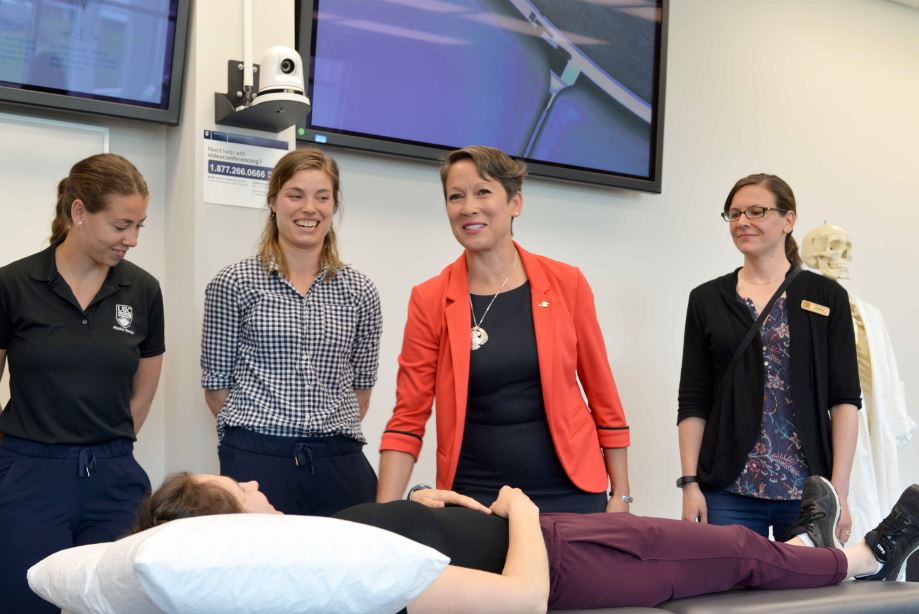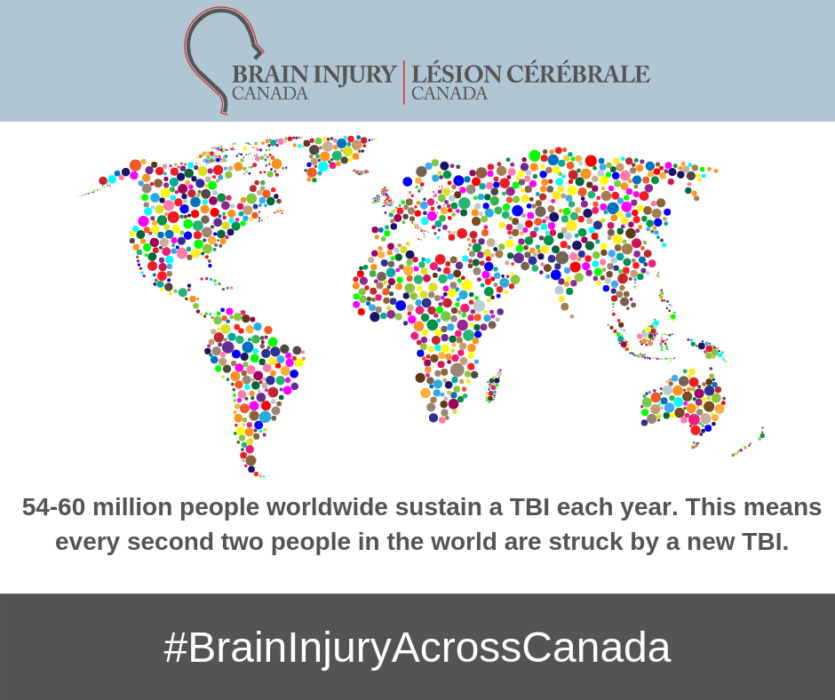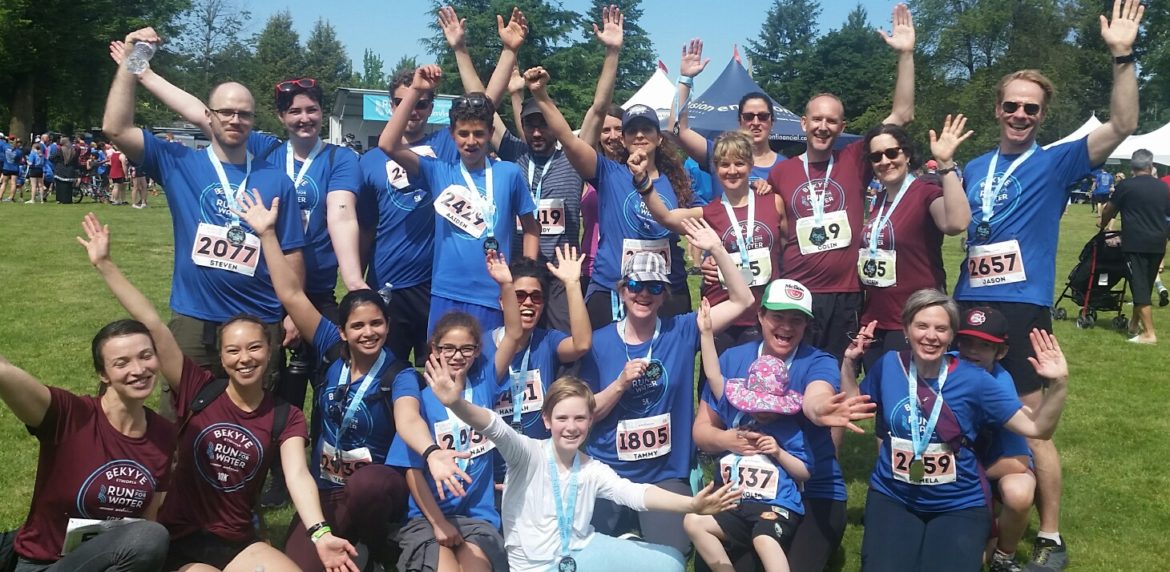OT Assessment: What to Expect
Getting Started with an Occupational Therapist
Occupational therapists are client-centered problem solvers. With an OT’s help, clients can increase their ability to take care of themselves, be productive, and enjoy what their homes and communities have to offer.
Occupational therapy begins with a thorough assessment to identify a client’s current abilities and how to maximize their functioning so that they can achieve their personal goals. OTs check their client’s physical, cognitive and emotional abilities and explore any assistive devices, social supports and environmental setups they have or need.
When to Refer to an OT
If a person shows a decrease in daily function, an OT assessment can determine if occupational therapy is right for them. The Canadian Association of Occupational Therapists (CAOT) suggest an assessment may be helpful if a person has had an accident or a change in health status and shows any of these signs:
- They have not returned to work, school, volunteering or other pre-accident roles.
- They struggle to care for themselves, their family or their home.
- Despite other treatments, they are still recovering slowly or not at all.
Initial assessments are also beneficial for insurers who request our OTs’ help. An OT’s observations and recommendations provide clarification for the insurer so that they can arrange funding and coordinate treatment providers. An assessment is particularly useful to determine how a person participates in activities of daily living (ADLs) and how those activities are affected by the injury at hand.
What happens with an OT Assessment?
An OT assessment is a process that usually involves an in-person meeting and a written report. During the assessment, the therapist will typically:
- Gain an understanding of the client’s pre-injury status. How did the client engage in activities before their function decreased?
- Observe the client doing functional tasks in their real environment(s), as well as standardized testing. What are the physical, cognitive and emotional barriers affecting the client’s ability to engage in daily activities as before? What physical, emotional and social supports does the client have in the home, at work or in their community?
- Develop a collaborative plan for treatment. What specific skills or supports require improvement? Is education or ongoing treatment necessary? How does the treatment plan reflect the client’s specific needs and goals as well as current medical research?
- Write a report for the insurer and other health providers. What information would other parties benefit from knowing about the client’s situation? What objective, measurable goals will help a client to their pre-injury function?
Different Kinds of OT Assessments
OT assessments vary depending on the nature of the referral (also known as the “referral question”), the environment for the assessment and the needs of the client. Here are some examples of assessments with a specific focus.
- Hospital Discharge Planning – assess the need for adaptive equipment, home modifications or home support services such as cleaning services or a care aide when a client may be unsafe upon returning home after hospitalization.
- Cognitive Rehabilitation – if the client has experienced a concussion or traumatic brain injury due to the accident, or reports changes in thinking due to a mental health condition, an OT can assess those specific changes. In particular, they assess attention, memory, information processing, and executive function (such as planning).
- Ergonomic Assessment – sometimes an injury doesn’t prevent the client from returning to work but they experience ongoing or increasing symptoms while at work. In this case, an OT assesses the desk, chair and computer set up, particularly to prevent shoulder, neck, back, hip and wrist pain.
- Return-to-Work Planning – if the client cannot return to work due to their injuries, an OT can liaise with their employer to develop a step-by-step plan that gradually reintroduces the client back into their pre-injury worker role. OTs also determine if and how activities, tasks and work roles can be modified in the short or long-term, when medically required.
Where does it take place?
The initial assessment can occur at the client’s home, in their community, or at their workplace. Some also take place in hospitals, clinics or community health centers. Our OTs work in their community. They come to the client to assess their function “in vivo”, which means where they spend most of their time. Our OTs see clients in Greater Vancouver, the Fraser Valley and the Sea-to-Sky area (Squamish, Whistler, Pemberton). We also serve clients on the Sunshine Coast and Vancouver Island.
What do you get from an OT assessment?
Once an assessment is complete, the client and their insurer can review the OT’s recommendations, often as a report. If medically supported and advised, the OT may recommend further follow-up meetings for continued OT treatment.
Some clients start OT already knowing they would benefit from ongoing treatment. For instance, return-to-work planning may require monitoring as an OT’s presence can assist a client as they gradually ease back into their routine. Other clients and fee-payers may be unsure whether longer treatment options are necessary. Nonetheless, an initial assessment is a good place to start and provides professional expertise to determine how to move forward.
How can OT Works! help?
Our occupational therapists are experienced with a wide range of assessments and tools. They have developed unique, client-centered treatment plans that have helped hundreds of people return to their pre-injury status and make the best of their situations.
All of our OTs are university-trained and certified by the College of Occupational Therapists of British Columbia (COTBC). Many of our OTs have additional training in physical OT treatment, mental health, and goal-planning, to name a few. They enjoy working with a variety of insurance providers including ICBC, WorkSafe BC, Pacific Blue Cross, and Great West Life. Our therapists know what steps to take to ensure all parties are content with the outcome of the assessment.
Contact us today if you or your client could benefit from an OT assessment. We would be happy to discuss your needs or answer any question you may have.
Email: referrals@ot-works.com
Phone: 604.696.1066 ext. 1000.
Expansion of OT Training Programs in BC
With a growing demand for occupational therapists in urban and rural areas of British Columbia, OT Works! is thrilled with the recent announcement by the Government of BC and the University of British Columbia to expand occupational therapy programs. UBC hosts the only OT school in BC and many of our OTs are alumni of their Master’s program. UBC will add an occupational therapy program in northern B.C. in partnership with the University of Northern British Columbia, with its first intake starting September 2022. The OT program at UBC-Vancouver also plans to add 8 seats to its program in the coming years.
OT Works! looks forward to working with more UBC and UNBC grads in the future. Together, we can improve the health and wellness of our local communities.
Read More
- “Occupational and physical therapy programs expand to northern B.C.” UBC Faculty of Medicine. https://www.med.ubc.ca/news/occupational-and-physical-therapy-programs-expand-to-northern-b-c/
- “Burnaby doesn’t have enough occupational therapists to staff new networks.” Burnaby Now. https://www.burnabynow.com/news/burnaby-doesn-t-have-enough-occupational-therapists-to-staff-new-networks-group-1.23771316
Photo Credit: UBC Faculty of Medicine – University of British Columbia
Exposure Therapy and OT
After an emotionally difficult experience you may find it challenging to fully participate at work, at home or in social situations. Exposure therapy is a treatment Occupational Therapists use to increase a client’s ability to function after trauma. OTs use exposure therapy to address anxiety, fear and discomfort so that you can actively engage in you community and life again.
What is Exposure Therapy?
Exposure therapy helps clients improve their ability to differentiate between safe and unsafe situations. With an OT’s help, they can reduce the physical, emotional, cognitive and social symptoms of trauma. Early intervention along with repetition empowers clients to better manage their response to triggers.
When someone experiences anxiety about specific people, places or things, they often avoid those situations. While this can reduce the discomfort in the short term, longer-term solutions are better. Interrupting the cycle of fear, through exposure therapy, allows a person to better recognize which beliefs are accurate and which have become overrun by emotions and difficult memories.
How is Exposure Therapy done?
- Education: Discuss how avoidance behaviours fuel anxiety.
- Which safety habits does the client use in order to reduce anxiety in the triggering situation?
- What thoughts and beliefs about the situation may be inaccurate or not helpful?
- Develop a structured plan to overcome the anxiety.
- The OT and their client develop an exposure hierarchy by grading all the aspects about the situation that causes anxiety. They assign each a score that ranges from 0/10 (no anxiety) to 10/10 (most anxiety ever).
- Based upon these scores, the OT and client develop a step-by-step plan to address each aspect of anxiety. Initial sessions should work through less anxious tasks and later sessions should address those that cause more anxiety.
- In the final sessions, the client aims to manage their anxiety effectively so that they can engage in the formerly stressful situation with a calm and clear mindset.
- During each session: Consider how long to continue with the session before it is complete.
- Researchers suggest that the client and OT stay in the situation until their level of fear drops by 50%. If the client considered their anxiety to be a 8/10 initially, they should wait until it is a 4/10 before concluding that exposure step.
Meet Kadie: A Case Study in Exposure Therapy
After an isolated and traumatic event occurred during her work as a social worker, Kadie feared her safety whenever she came near the site of the incident. Jennifer MacDonald, a senior therapist with OT Works! started working with Kadie after she had been off work for 6 months. They used a team-based approach to organize the exposure plan with the rest of Kadie’s healthcare team and social network. They had one-on-one sessions that gradually reintroduced her back into her work role. At discharge, Kadie was able to return to work independently, equipped with the tools and skills to work effectively without tirelessly worrying about her safety. With exposure therapy, Kadie built up confidence in her ability to manage feelings of anxiety.
How can OT Works! help?
Our occupational therapists are experienced in exposure therapy. They have helped many clients face their fears and reduce their anxiety. Our clients are able to return to their daily activities and enter unfamiliar situations equipped with the tools that are gained from exposure. All of our therapists are certified with the College of Occupational Therapists of British Columbia (COTBC) and many have additional training in mental health treatment.
If you or anyone you know could benefit from exposure therapy, contact us at referrals@ot-works.com or 604.696.1066 ext. 1000. We can connect you with one of our therapists and make recovery more attainable for everyone.
Additional Resources
To learn more about exposure therapy, check out these resources:
- American Psychological Association – Exposure Therapy
- Anxiety Canada – Facing Fears
- HealthLink BC – Exposure Therapy
- Very Well Mind – How Exposure Therapy Can Treat PTSD
#BrainInjuryAcrossCanada
June is Brain Injury Awareness Month by Brain Injury Canada – an advocacy movement by brain injury associations, survivors and caregivers throughout the country. Their mission “is to enhance the quality of life of individuals and families/caregivers living with brain injury in Canada.”
Did you know that approximately 1.5 million Canadians live with a brain injury? Acquired brain injuries, that occur due to trauma after birth, can affect thinking, sensations (including touch, taste, light, sound and smell), language and emotions. Often, they appear as a part of a silent epidemic; concussions, impaired cognitive and behavioural functioning are not necessarily as visible as other disabilities. Everyone involved in brain injury rehabilitation and recovery face the social, emotional and economic consequences that arise, even if they are not a survivor themselves. It is important for survivors and community members to share their stories and demonstrate how brain injuries can be overcome.
Enrico Quilico: Athlete, Educator, Traumatic Brain-injury Survivor
Over a decade ago, Enrico nearly lost his life when he was thrown from his motorcycle while veering to avoid a car in front of him. He spent two weeks in an induced coma. Doctors told his parents to think about whether he should remain on life support when he did not initially wake up.
When he did regain consciousness, Enrico had to re-learn many basic skills like walking and proper pronunciation. He credits his recovery, to the point he is at now, due to continuous exercise. He has competed in over 16 triathlons and, in 2016, he participated in the Ironman while raising funds in support of Brain Injury Canada.
Enrico has also earned several degrees since his accident. He has a Bachelor’s degree in education from Concordia University and a research-based Master’s degree in kinesiology and physical education from McGill. His research focuses on determining the benefits of physical exercise for others who have had similar experiences to him. Enrico was able to take a situation that seemed to negatively impact his life and turned it into something positive.
The OT Works! and Brain-Injury Rehabilitation
OT Works! is a proud supporter of Brain Injury Awareness Month. Every month, our team of occupational therapists meet for in-service education. In February of this year, OT Works! joined a webinar co-presented by Enrico on “The Importance of Exercising After Traumatic Brain Injury.” He shared his research and outcomes of a 9 to 12-month exercise program developed to help patients recover from a traumatic brain injury.
Our OTs continue to provide quality care while keeping up-to-date with current and emerging research and clinical evidence. Our OTs are knowledgeable on treating traumatic brain injuries and we have helped hundreds of clients with concussions return to the activities they love. Our OTs have advanced training and regularly attend brain injury rehabilitation workshops. Through their education, they help clients overcome their barriers in order to achieve success.
How Can We Help?
Give us a call if you are interested in how an OT can help you or someone you know with a traumatic brain injury.
Phone: 604.696.1066 ext. 1000.
Email: Referral@ot-works.com
Learn More
- “Overcoming a Motorcycle Crash to Becoming an Ironman” – The Epoch Times, May 1, 2019.
- “Co-Creating a Physical Activity Program for People with Traumatic Brain Injury” – Enrico Quilico’s Story on YouTube
- Brain Injury Canada – Website
- Acquired Brain Injury (ABI) Information – Factsheet (PDF)
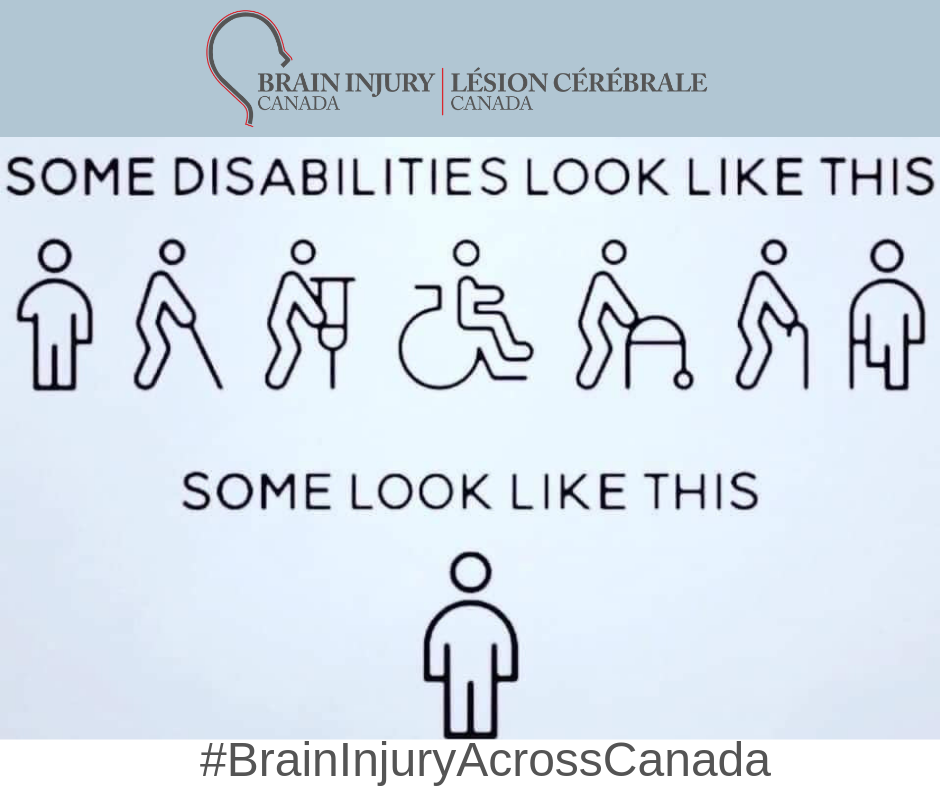
Ask Your GP About OT: Post-MVA
You may benefit from occupational therapy (OT) following a car accident, even if it is not initially included as a part of your treatment plan. All injured claimants are eligible to receive OT services under Part 7 Benefits. Ask your doctor about OT as they can provide you with a referral to pass onto your ICBC adjuster. The earlier you start occupational therapy, the more likely you are to successfully return to the activities that are important to you.
How do I know if occupational therapy would help me?
OT focuses on what its clients can and want to do. Questions to ask yourself include “Can I do everything I did before my accident?” and “Am I succeeding at work right now?”. If your answer is no to either question, OT might be right for you.
Here are some examples of how occupational therapy helps:
- Coordinating a smooth, safe discharge from hospital
- Reviewing equipment and strategies to improve walking and home safety
- Improving pain management
- Facilitating better memory for daily tasks
- Promoting better sleep, more energy and lighter mood
- Decreasing driving (or other) anxiety
- Providing education and empowerment while connecting you to other health resources and services you may need
- Getting back to dressing, bathing, cooking and cleaning (taking care of yourself or your loved ones), as well as getting into the community again
- Finding ways to safely get back to your work, as comfortably as possible
- Helping you return to your meaningful leisure activities
What should I expect from my occupational therapist?
OTs are university educated healthcare providers and are required to be licensed to practice in BC. You can expect them to:
- Provide objective and medically supported assessments and treatments
- Address your physical, emotional, and cognitive needs
- Use interventions to get back to life
- Focus on activities of daily living (ADLs) including personal care, productivity (at work or school) and leisure
What is the home assessment like?
The assessment begins with a clear understanding of your medical status, prior to meeting you. The OT then meets with you in your home for your comfort and privacy and to understand your specific, individual needs. The OT will do the following, during a 2-hour visit:
- Introductions, answering any questions you might have about OT or the recovery process, and ICBC’s involvement in that process
- A thorough interview to understand your symptoms, concerns, abilities and goals
- Use standardized tools to assess physical, cognitive or emotional impairments
- Observe you doing tasks around the home to ensure safety and/or explore ways to make them easier on your body
- Review the physical safety of your home
- Review treatment options with you
The OT has your safety and comfort in mind at all times; you can ask for breaks or stop the assessment and continue at another day or time at any point.
Resources
Read more about what OT can do for you and your ICBC claim – CAOT-BC Briefing Note (May 2018)
Supporting Our Global Community: 2019 Run for Water
Last Sunday, OT Works! therapists and their families ran in support of Bekkye and other communities in Ethiopia. The 2019 Run for Water at Mill Lake Park (Abbotsford) raises funds for clean drinking water projects in these rural areas.
OT Works! Involvement
While our OTs work locally, we also want to have a global effect. As healthcare providers, OT Works! recognizes the impact one’s environment can have on well-being. By improving access to clean water, a community can transform. We are thrilled to have fund-raised and contributed over $2,226 to clean drinking water in Bekyye, Ethiopia.
About Bekyye
Bekyye currently has no access to clean water. Girls and women journey for hours every day to fetch water from rivers and ponds for cooking, cleaning, drinking and animal care. With the funds raised last weekend, as well as funds mobilized by the community of Bekyye itself (who are raising 10% of the project cost), access to safe, clean, and local drinking water can become a reality. The project aims to enable:
- Children to attend school
- Mothers to start businesses
- Fathers to water their crops
- Reduction in the transmission of waterborne diseases

Meet Kibra
Kibra is the youngest of 10 children and besides having to walk for two hours every day to fetch water for her family, she was travelling on foot for another two hours a day just to get to her elementary school. Five years ago, Run for Water began a sponsorship program in the communities where they bring clean water; this sponsorship provides a scholarship for girls to go to high school and university. Kibra was one of those recipients. Her story is an incredible example of what a small investment can do to change an entire community. Watch her story here:

Learn more and donate at Runforwater.ca.
Return-To-Work: The OT’s Role
Occupational therapists (OTs) support you during your transition back into the worker role after an injury or accident. OTs facilitate realistic and proactive return to work planning that considers all of the factors that impact success. Our OTs partner with you to develop plans that enable you to re-build your specific work skills, and the confidence needed for long-term success.
Location of Services:
Our OTs meet you at your home and workplace to develop a return-to-work plan and to facilitate your progress.
Examples of Services:
- Job Site Visit
- Job Demands Analysis
- Assistive Technology
- Ergonomic Assessments
- Assessing Function in relation to Work Demands
- Gradual Return-to-Work (GRTW) Planning
- Gradual Return-to-Work (GRTW) Monitoring
- Vocational Assessment
- Accommodations
How can OT help me return to work?
- Assess return to work readiness
- Provide education, strategies and coping tools
- Facilitate symptom management
- Prescribe and organize appropriate assistive and ergonomic equipment
- Develop personalized plans with attainable goals
- Advocate for return to work options with your employer
- Provide on- and off-site coaching
Who can refer me?
There are many professionals who can refer you to RTW Occupational Therapy. These include:
- Medical providers, such as your GP, physiotherapist, psychologist, etc.
- Public services, such as WorkSafe BC, ICBC, health authorities and hospitals.
- Other professionals involved in your recovery, such as your insurance specialists, adjuster or lawyer.
Who pays?
OT services are typically funded by WorkSafe BC, ICBC, your extended health insurance coverage, health authorities or legal settlements. You or your family can also pay for your treatment privately.
Why OT Works?
We have assisted clients as they returned to work and other meaningful activities since 2001. At OT Works!, treatment is client-centred. Every assessment and intervention is individualized so that your goals are in mind. While our knowledge is extensive, we have a particular focus on cognitive challenges (mental health and concussions) and ergonomics. Regardless of the nature of your challenges, we will partner with you to develop a plan built for your success. We help you return to work so that you can stay at work.
#GetLoud – CMHA Mental Health Week (May 6 – 12, 2019)
Mental health is a state of well-being, and we all have it.
Mental health is about more than being happy all the time. It’s about feeling good about who you are, having balance in your life, and managing life’s highs and lows. We might have a mental illness, and we might not. Either way, we can all feel well. We can all have good mental health.
This May 6th to 12th, you can #GetLoud about what mental health really is. Research shows that there are six common features of good mental health: a sense of self, a sense of purpose, of belonging, contribution, enjoyment and resilience. Here are some examples of what mental health looks like to Canadians:
- I don’t worry too much about what people think of me.
- I feel like I’m reaching my potential.
- I feel like I belong.
- I make the world a better place.
- I enjoy my life.
- Knock me down and I’ll get back up again.
Visit https://mentalhealthweek.ca/ for more information on CMHA’s 2019 Mental Health Week.
How can we help?
OT Works! helps clients with their mental health. We have significant experience working with individuals with mental health challenges
such as depression, anxiety after an accident or concussion. Here are some examples of services we can provide:
- Behavioural Activation
- Cognitive therapy
- Exposure Therapy
- Mindfulness Strategies
- Assistance Daily Living
- Graduated Return-to-Work support
Some of our OTs focus their practice around mental health Find out more at https://www.ot-works.com/about/the-team/ or call us at 604-696-1066.
Additional Resources
- Mental Health Checklist – https://mentalhealthweek.ca/check-in-on-your-mental-health/
- “How is mental health like physical health?” – https://mentalhealthweek.ca/how-is-mental-health-like-physical-health/
- “16 strategies to help you thrive” – https://mentalhealthweek.ca/16-strategies-to-help-you-thrive/

Supporting Global Communities: 2019 Run for Water
As community OTs, we journey alongside many Canadians in the Lower Mainland. Last May, we extended our commitment to better health with the global community by participating in the Run for Water in Abbotsford, BC. We are excited to share that we will put on our runners and grab our water bottles again this May 26th for the 2019 Run for Water!
Learn more and join the movement for clean water, visit
https://www.facebook.com/RunForWater/.

Health & Safety in the Office: Ergonomics
An effective workspace is essential to feeling well at work and wherever else. Ergonomic changes to your workspace promote good posture and contribute to physical wellbeing. They also allow better efficiency with tasks. Consider the ergonomic recommendations below and seek professional help from a registered occupational therapist if you need more help.
Ergonomic Recommendations
Consider the following:
- Posture.
- Are you sitting up straight?
- Are your shoulders relaxed?
- Are you leaning forward, creating tension in your back?
- The height of your chair.
- Are your forearms horizontal, your wrists straight, and your thighs at a 90 – 110 degree angle at the hips?
- Does the lower part of your backrest support the curve of your back?
- Do you have armrests, to decrease the strain on your back and neck?
- Your computer monitor.
- Is the top line of text on the screen at eye level?
- Is the screen an arm’s length away from your eyes?
- Do you need to adjust the contrast, brightness, or font size on the screen?
- Your visual needs.
- WorkSafe BC has a list of information to share with your ophthalmologist or optometrist regarding your desk and computer work.
- Do you need to lower the overhead light levels to prevent glare?
- Do you need to move your desk lamp (to the opposing side to your dominant hand)?
- Your work area organization.
- Are frequently used items close to you (within a 30 cm reach)?
- Are occasionally used items within an arm’s reach to you (within a within a 50 cm reach)?
- Are any rarely used items put away or set further aside?
- Your phone set up.
- Do you use a headset or speakerphone to avoid awkward neck positions?
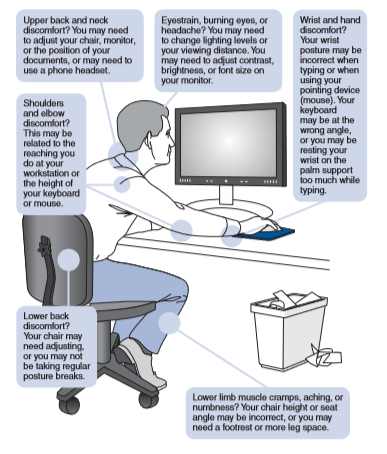
Take short breaks (20 sec. to 2 min.) to allow your muscles to rest between repetitive activities. On longer breaks, stand up and walk around so that you use different muscles than while sitting. Try basic exercises like these here or here to help you prevent strains at work.
You may find an ergonomic assessment by an OT to help address any issues you have. Contact us and we will be happy to have an occupational therapist come to you.
E-mail: info@ot-works.com
Phone: 604.696.1066 ext 1000
Resources
- “Ergonomics & Computer Use.” University Health Services at Princeton University. https://uhs.princeton.edu/health-resources/ergonomics-computer-use
- “Office Ergonomics.” HealthLink BC. https://www.healthlinkbc.ca/health-topics/tr5915
- “How to Make Your Computer Workstation Fit You.” WorkSafeBC. https://www.worksafebc.com/en/resources/health-safety/books-guides/how-to-make-your-computer-workstation-fit-you


